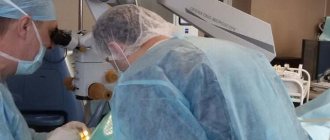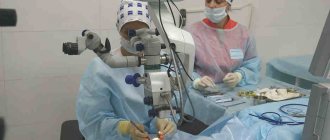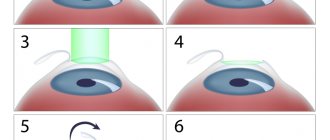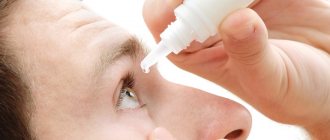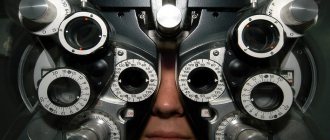According to statistics from the World Health Organization (WHO), today at least 150 million people in the world have low vision, which is caused by refractive errors - myopia, farsightedness and astigmatism. Moreover, in most cases, these disorders can be corrected using modern ophthalmology.
One of the most popular ophthalmological operations today is laser vision correction. It allows people with refractive errors to see clearly again and gain freedom from external correction devices - glasses and contact lenses. To date, specialists use several effective methods of laser correction. But medical technologies do not stand still, and the already traditional options are being replaced by new, increasingly effective and safe techniques.
One of the innovative surgical methods for correcting refractive errors is the ReLEx® SMILE procedure. It allows you not only to give up glasses, but also to lead an active (and even extreme) lifestyle in the future, which was practically inaccessible before.
Features of SMILE
The traditional procedure for refractive correction using the LASIK method involves the surgeon cutting a flap of the cornea (flap), which is folded back, and then the laser removes sections of the corneal tissue point by point, due to which the cornea takes the necessary shape and the refraction becomes normal. The ReLEx SMILE technique used today makes it possible to carry out laser correction without forming a flap from the corneal membrane (flap) and makes this version of laser vision correction minimally invasive, while maintaining the strength of the cornea.[3]
For a simpler understanding: LASIK and SMILE are like removing the gallbladder in general surgery through large incisions “throughout the entire abdomen” or laparoscopically “through a puncture”. The result is the same (getting rid of the disease), but the pain, rehabilitation period and risks of complications in the second case are much less.
Fig. 2 Stages of correction: A - general view B - laser formation of the lenticule and incision C - separation of the lenticule D - extraction of the lenticule using tweezers
At the first stage of surgical intervention, the corneal lenticule and microtunnel (2 mm) are formed for its extraction using the VisuMax femtosecond laser. Both actions are performed almost simultaneously (25 seconds for each eye). Next, the corneal lenticule is separated with a spatula (separated) and removed from the thickness of the cornea.
At the same time, since the flap from the corneal membrane (flap) was not cut out, we are talking only about minimal intervention in the biomechanics of the cornea. The incision made does not require sutures and self-seals in a short time (1-2 hours).
Progress of the ReLEx® SMILE operation
The ReLEx® SMILE operation is performed in one day under local anesthesia.
- At the first stage, using a ZEISS VisuMax femtosecond laser, an optical lenticule is formed in the thickness of the cornea, and a small incision of up to 4 mm is made along the periphery of the cornea.
- At the second stage, the surgeon mechanically removes the optical lenticule through a small incision previously formed with a femtolaser.
- At the third stage, the surgical field is washed, after which the operation is completed without suturing.
- The next day after the ReLEx® SMILE procedure, the patient returns to normal active life, no longer wearing glasses or contact lenses.
MORE ABOUT THE OPERATION >>>
What vision can be corrected?
Using SMILE technology, you can correct myopia from -0.5 to -10 diopters, astigmatism from 0 to -5 diopters. When combined, the spherical equivalent is up to -12.5 diopters in one procedure.[4]
If myopia is higher than these values, and the thickness of the cornea allows it, two operations can be performed!
For farsightedness (hyperopia), the method is not currently used (clinical studies have been completed, approval for practical use is expected within 1-2 years).
results
Predictability
. 6 months after surgery, SE was (–) 0.08±0.4 diopters. 79.5% of patients (126 eyes) had ±0.5 diopters of the specified emmetropic refraction (Fig. 3).
Rice.
3. Predictability 6 months after ReLEx SMILE surgery. The x-axis is the planned SE (in diopters); along the ordinate - the resulting SE (in diopters), the trend line with the equation and the value of the approximation reliability. Safety
. 6 months after surgery, 6% of patients (10 eyes) gained 1-2 lines from BCVA, in 87% (138 eyes) BCVA remained unchanged, 6% of patients (10 eyes) lost 1 line and 1% (1 eye) lost 2 lines (Fig. 4).
Rice.
4. Safety of the ReLEx SMILE operation after 6 months. The x-axis is the number of lost lines; the y-axis is the frequency of loss of BCVA (in %). Efficiency
. 6 months after surgery, 95% of patients (151 eyes) had an uncorrected visual acuity (UCVA) of 0.8 or higher and 79% (125 eyes) reached 1.0 (Fig. 5).
Rice.
5. The effectiveness of the ReLEx SMILE operation after 1, 3 and 6 months. The abscissa shows UCVA after 1, 3 and 6 months; along the ordinate - the number of eyes (in%). Stability
. 1 month after surgery, the average SE was (–) 0.14 D, after 3 months — (–) 0.16 D, after 6 months — (–) 0.08 D (Fig. 6).
Rice.
6. Stability of the ReLEx SMILE operation after 1, 3 and 6 months. The x-axis is time after surgery; along the ordinate - average SE. Side effects and complications
. No serious complications were observed during vision correction using the ReLEx SMILE method using the developed algorithm. Among the intraoperative complications, a tear of the cornea in the incision area was noted in 3.6% of cases (6 eyes). Of the postoperative complications, epithelial ingrowth was detected in 1.8% of patients (2 eyes) and dust-like intact inclusions were found in the stromal pocket in 1.8% of cases (2 eyes), which did not affect the visual result. No other complications—diffuse lamellar keratitis, photophobia, irregular astigmatism—were noted.
How does the patient feel?
In the operating room, the patient is placed on the operating table, given instructions, and anesthetic drops are instilled for local anesthesia.
After this, a special spring (eyelid expander) is inserted, which will not allow you to blink during the procedure. All manipulations are painless. The patient is then moved directly under the laser. All that is required of you is to look at the green light and not move your eye.
The laser cone is suctioned to the surface of the cornea and fixes the eye using a slight vacuum. The impact is not strong, so if the patient takes his eye to the side, there will be a loss of vacuum and the operation will stop. The surgeon will have to repeat the procedure again. Therefore, do not move your eye and look at the green mark all the time.
After centering the pupil, the laser correction procedure itself will begin.
The laser will first form the lower part of the lenticule, then the upper. Lastly, a side cut is formed, through which the doctor will remove the lenticule using tweezers. The laser operates for an average of 25 seconds, after which the vacuum is turned off and the patient moves under the operating microscope. Instead of a green light, only “fog” is visible.
The next stage is the expansion of the side incision and separation (separation) of the lenticule using a spatula. After this, the leticle is removed using tweezers and its integrity is checked. The corneal pocket is washed. At the end of the operation, antibacterial drops are instilled into the eye, and the eyelid speculum is removed.
Immediately after the correction, there may be fog before the eyes, slight tingling and watery eyes - this is normal and goes away within a few hours.
Differences between SMILE and other laser correction methods
The SMILE technique is performed on a VisuMax® femtosecond laser system. VisuMax® radiation is short, high-energy laser pulses. They allow cutting out an internal flap in the corneal stroma - a lenticule (an optical lens made from corneal tissue) without creating a superficial valve.
The main difference between SMILE and the common methods of PRK, LASIK, Super LASIK and Femto LASIK is that this technology does not leave visible wounds and scars on the cornea, which means that healing time is not required. The patient gets rid of myopia and does not feel a burning sensation in the eyes after the operation and does not experience watery eyes.
It is worth noting that technically this operation is somewhat more complicated than conventional LASIK and does not always guarantee the patient 100% vision. The recovery period may even be longer than usual. In addition, it is not recommended to correct mild degrees of myopia, astigmatism and hypermetropia using this method, since sometimes a very thin lenticule is difficult to completely remove from the bed. At the same time, this method is indicated for patients with thin corneas and high degrees of myopia.
ReLEx® SMILE is effective and safe, just like all popular laser correction methods, it is gentle on the corneal epithelium and has a specific list of indications, including for those for whom these treatment options are not recommended.
Rehabilitation process
After the operation, there is no need to apply a blindfold, but it is advisable to use sunglasses, because eyes may be sensitive to light. On the day of surgery, you should not drive or rub your eyes. The entire rehabilitation period takes about a week, during which it is necessary to drip medications (a combination of antibacterial and anti-inflammatory drugs) and artificial tear drops into the eyes.
The very next day after such a gentle intervention, you can start working and resume sports activities, excluding swimming.
You can drive a car only after a medical examination, which is scheduled the day after the operation (when the doctor is convinced that your visual acuity is sufficient for driving).
Fig. 3 Patient under the VisuMax femtosecond laser from Zeiss
How to prepare for correction
Before diagnosis and correction, it is necessary to follow some recommendations:
Before diagnosis and correction, you should not wear soft contact lenses for 7 days, and hard lenses for 3 months.
You should not use decorative cosmetics for 1 - 3 days before correction.
Service name
It is recommended to wash your hair before the laser correction procedure, since afterward this cannot be done for 3 to 5 days.
You should not drive for diagnostics and laser correction.
On the day of laser correction, you can eat and drink as usual, but a light meal is recommended before arriving at the clinic.
You should arrive for laser correction with an accompanying person.
Schedule of doctor visits after laser vision correction
- The next day
- In 2 weeks
- In 1 month
It is important not to miss scheduled follow-up examinations in the first month after correction. Further visits to the doctor and recommendations are prescribed as needed depending on the ophthalmological status of the patient.
Observation for 1 year after correction is free! Promotion details here
Advantages of ReLEx SMILE
Performing laser vision correction using the Smile technique has a lot of undeniable advantages over traditional PRK and LASIK techniques:
- Can be performed for patients aged 16-17 years (with stable refraction).[5]
- It is suitable for patients with high degrees of myopia (up to -10 D), dry eyes, thin corneas, athletes and divers.
- A quick procedure (25 seconds per eye) using only 1 laser (with Femto-LASIK, two - femtosecond and excimer).
- When performed, the strength of the cornea is maintained (minimal risks of developing keratoconus).
- The procedure has a short period of restrictions (24 hours), after which there is a rapid recovery.
- Vision correction is possible for moderate degrees of astigmatism (up to -5 diopters).
- There are no unpleasant odors (“burnt cornea”) during the procedure.
- Rapid improvement in visual acuity and stability of the result (no “regression” of myopia).
- Minimal risk of infectious complications and complete absence of valve complications (flap displacement).[6]
- Maximum predictability of correction results and absence of traces of surgery.
ReLEx® SMILE (SMILE) - a new method of laser vision correction
At the Eye Clinic, Dr. Belikova closely monitors the development of the latest methods for treating eye diseases. We analyze global and domestic experience, after which we introduce clinics into practice and offer our patients the best, safest and, of course, painless and effective treatment methods.
In recent years, much attention has been paid to a new technique of femtosecond laser vision correction - surgery using the ReLEx® SMILE method. The name is formed from the first letters of the full name of the method - Small Incision Lenticula Extraction (lenticule removal through a small incision).
The technique originated and received its first results in Germany. The developer of technology and equipment is the world-famous company Carl Zeiss Meditec.
Reviews from patients after surgery
Sergey Nazarov, 27 years old
I deliberately chose the SMILE method as the best one to date. His eyesight has been poor since childhood, and his job (as a programmer) completely spoiled him. It took me a long time to decide and study this issue (I probably had doubts for more than a year). But my -4 is still a “serious problem” that required constant wearing of glasses (lenses were not suitable due to dryness, and I don’t really like getting into my eyes).
I liked the quick recovery and the fact that there are no large incisions. It didn’t hurt, there was a “fog” for about an hour after the operation, the eyes were a little muggy when the freeze went away, but immediately my vision was better than before the operation.
The cost, of course, is higher than other methods (this is the only negative, in my opinion), but I regard this as an investment in my health. Moreover, eyes are not a tooth, of which there are 32...
Reviews
| Alexandra Lysenko - “Hurray! I’m no longer a bespectacled person!” exclaimed my inner voice as I left the Comb Clinic. A couple of days ago, at the Rascheskov clinic, my vision was restored using the new SMILE laser correction technology. Just 10 minutes - and life began to sparkle with new colors. The only thing I regret is that I didn’t do this earlier! |
